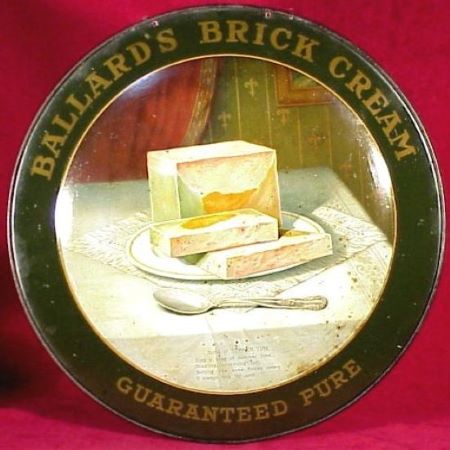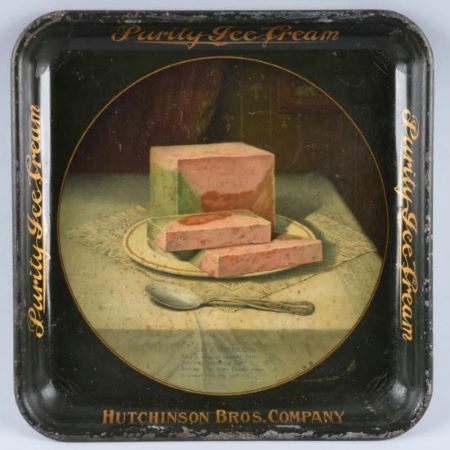The 'Stock' Exchange
The Meek Co.: No. 96 "Song of Summer Time"
The Meek Co.: No. 96 "Song of Summer Time"
Date: 1908 - 1912
Size: 13" & 13.5" x 13.5"
Type: Pie
Scarcity: Scarce
Value: $$$ to $$$$
Condition & Brewer Dependent
Size: 13" & 13.5" x 13.5"
Type: Pie
Scarcity: Scarce
Value: $$$ to $$$$
Condition & Brewer Dependent

General
Although a number of previous designs were suggestive of, or well suited for, particular products, No. 96 is the first design intended for a specific, single product: ice cream. Not unexpectedly, we’ve never encountered a brewery example of this design; however, we’ve included it for continuity of the stock catalogue.
Ice cream's origins reach back as far as the second century B.C., when Alexander the Great enjoyed snow and ice flavored with honey and nectar. Biblical references also show that King Solomon was fond of iced drinks during harvesting. During the Roman Empire, Nero Claudius Caesar (A.D. 54-86) frequently sent runners into the mountains for snow, which was then flavored with fruits and juices. These snow-based fore-runners eventually evolved into something similar to sherbet (or sorbet) when Marco Polo returned to Italy from the Far East with a recipe. Historians estimate that this recipe evolved into ice cream sometime in the 16th century, although this was exclusively available only to royalty. It wasn’t until the latter half of the 17th century that ice cream started to become available to the general public.
The first official account of ice cream in the New World comes from a letter written in 1744 by a guest of Maryland Governor William Bladen. The first advertisement for ice cream in this country appeared in the New York Gazette on May 12, 1777, when confectioner Philip Lenzi announced that ice cream was available "almost every day." Records kept by a Chatham Street, New York, merchant show that President George Washington spent approximately $200 for ice cream during the summer of 1790. Inventory records of Mount Vernon taken after Washington's death revealed "two pewter ice cream pots." President Thomas Jefferson was said to have a favorite 18-step recipe for an ice cream delicacy that resembled a modern-day Baked Alaska.
Until 1800, ice cream remained a rare and exotic dessert enjoyed mostly by the elite. Around 1800, insulated ice houses were invented. Manufacturing ice cream soon became an industry in America, pioneered in 1851 by a Baltimore milk dealer named Jacob Fussell. Like other American industries, ice cream production increased because of technological innovations, including steam power, mechanical refrigeration, the homogenizer, electric power and motors, packing machines, and new freezing processes and equipment. In addition, motorized delivery vehicles dramatically changed the industry.
Wide availability of ice cream in the late 19th century led to new creations. In 1874, the American soda fountain shop and the profession of the "soda jerk" emerged with the invention of the ice cream soda. In response to religious criticism for eating "sinfully" rich ice cream sodas on Sundays, ice cream merchants left out the carbonated water and invented the ice cream "Sunday" in the late 1890's. The name was eventually changed to "sundae" to remove any connection with the Sabbath.
The technological evolution that made ice cream more available and the emergence of dedicated establishments for serving it obviously caught the attention of the tray makers. In addition, the increasing calls for prohibition of alcohol must have made the decision to diversify into attracting new user seem like a no-brainer.
Sahling has an entry in his workbook for “Stock tray No. 96” in November 1908, although there is no further description.
Size & Shape and Advertising Placement
As a tray, this design primarily comes as a convex pie, although we have seen a square version. In addition, we have seen a few curled corner signs (with a round image) and a round sign or unpressed tray (we are aware that some collectors consider these chargers). Rims are black with gold text, as is typical of other designs at this time. There is text on the face of the tray, but apparently it is part of the design, as it is found on all of the versions we’ve encountered.
Hager & Price
Hager does not discuss or include this design; either he hadn’t encountered it, or did not realize it was part of the Coshocton catalogue. As mentioned above, we’ve never encountered a brewery example (nor do we expect to); all examples have been from dairy or ice cream companies. Prices are comparatively strong for non-brewery trays we assume because there are dedicated ice cream collectors.
Although a number of previous designs were suggestive of, or well suited for, particular products, No. 96 is the first design intended for a specific, single product: ice cream. Not unexpectedly, we’ve never encountered a brewery example of this design; however, we’ve included it for continuity of the stock catalogue.
Ice cream's origins reach back as far as the second century B.C., when Alexander the Great enjoyed snow and ice flavored with honey and nectar. Biblical references also show that King Solomon was fond of iced drinks during harvesting. During the Roman Empire, Nero Claudius Caesar (A.D. 54-86) frequently sent runners into the mountains for snow, which was then flavored with fruits and juices. These snow-based fore-runners eventually evolved into something similar to sherbet (or sorbet) when Marco Polo returned to Italy from the Far East with a recipe. Historians estimate that this recipe evolved into ice cream sometime in the 16th century, although this was exclusively available only to royalty. It wasn’t until the latter half of the 17th century that ice cream started to become available to the general public.
The first official account of ice cream in the New World comes from a letter written in 1744 by a guest of Maryland Governor William Bladen. The first advertisement for ice cream in this country appeared in the New York Gazette on May 12, 1777, when confectioner Philip Lenzi announced that ice cream was available "almost every day." Records kept by a Chatham Street, New York, merchant show that President George Washington spent approximately $200 for ice cream during the summer of 1790. Inventory records of Mount Vernon taken after Washington's death revealed "two pewter ice cream pots." President Thomas Jefferson was said to have a favorite 18-step recipe for an ice cream delicacy that resembled a modern-day Baked Alaska.
Until 1800, ice cream remained a rare and exotic dessert enjoyed mostly by the elite. Around 1800, insulated ice houses were invented. Manufacturing ice cream soon became an industry in America, pioneered in 1851 by a Baltimore milk dealer named Jacob Fussell. Like other American industries, ice cream production increased because of technological innovations, including steam power, mechanical refrigeration, the homogenizer, electric power and motors, packing machines, and new freezing processes and equipment. In addition, motorized delivery vehicles dramatically changed the industry.
Wide availability of ice cream in the late 19th century led to new creations. In 1874, the American soda fountain shop and the profession of the "soda jerk" emerged with the invention of the ice cream soda. In response to religious criticism for eating "sinfully" rich ice cream sodas on Sundays, ice cream merchants left out the carbonated water and invented the ice cream "Sunday" in the late 1890's. The name was eventually changed to "sundae" to remove any connection with the Sabbath.
The technological evolution that made ice cream more available and the emergence of dedicated establishments for serving it obviously caught the attention of the tray makers. In addition, the increasing calls for prohibition of alcohol must have made the decision to diversify into attracting new user seem like a no-brainer.
Sahling has an entry in his workbook for “Stock tray No. 96” in November 1908, although there is no further description.
Size & Shape and Advertising Placement
As a tray, this design primarily comes as a convex pie, although we have seen a square version. In addition, we have seen a few curled corner signs (with a round image) and a round sign or unpressed tray (we are aware that some collectors consider these chargers). Rims are black with gold text, as is typical of other designs at this time. There is text on the face of the tray, but apparently it is part of the design, as it is found on all of the versions we’ve encountered.
Hager & Price
Hager does not discuss or include this design; either he hadn’t encountered it, or did not realize it was part of the Coshocton catalogue. As mentioned above, we’ve never encountered a brewery example (nor do we expect to); all examples have been from dairy or ice cream companies. Prices are comparatively strong for non-brewery trays we assume because there are dedicated ice cream collectors.


Confirmed Brewer used Stock Trays
Non-Beer Related & Non-Tray Uses
Click the Picture to Return to Meek & Beach Stock Catalog Page



